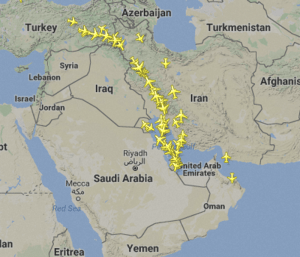 Political tensions in the Persian Gulf boiled over last week with a coalition of five nations, Saudi Arabia, Egypt, Bahrain, Yemen and the UAE, enforcing a blockade of Qatar. This action was sparked by false news stories from the Qatar News Agency (QNA) on May 23 2017, which attributed comments from the country’s Emir critiquing US and Saudi foreign policy in the region, and referring to Iran as a stabilising influence.
Political tensions in the Persian Gulf boiled over last week with a coalition of five nations, Saudi Arabia, Egypt, Bahrain, Yemen and the UAE, enforcing a blockade of Qatar. This action was sparked by false news stories from the Qatar News Agency (QNA) on May 23 2017, which attributed comments from the country’s Emir critiquing US and Saudi foreign policy in the region, and referring to Iran as a stabilising influence.
Qatar quickly denounced the posts and the veracity of their content, arguing that QNA had been hacked. This extended across agency’s media platforms, and is not unprecedented; the country’s National Bank was attacked last year, in an event which compromised over 15,000 files.
Regardless, the event is seemingly the straw that broke the camel’s back. The five partners have accused Qatar of supporting extremism, and proceeded to cut all relations. Qatari funding of Islamist groups in various countries, including the Muslim Brotherhood and Hamas, has long caused great consternation amongst many Arab states, and its state broadcaster Al Jazeera is loathed by the monarchy in Riyadh. Concerns over Qatar’s independent foreign policy previously led Saudi Arabia, Bahrain and the UAE to recall their ambassadors from Qatar for nine months in 2014, though an escalation of the standoff was averted.
As a result, Qatari flagged ships and aircraft are now prohibited from crossing into the territory of the aforementioned nations. This ban also extends to feeder services which call at Qatari locations, which has caused significant problems for inbound supply chains. The vast majority of Qatari sea freight imports have historically been transhipped from Jebel Ali in the UAE, whilst most food and beverage imports were previously trucked over the Saudi border.
However, several factors combine to ensure that Qatar, whilst inevitably weakened by the actions of the Saudi led coalition, is well-equipped to endure.
Firstly, the country can rely on highly developed air and sea infrastructure. Hamad International Airport in Doha is the second-largest air cargo hub in the region after Dubai International, and handled 1.7m tonnes of goods in 2016. Hamad Port became fully operational in December 2016, and has an annual capacity of 2m TEU, 1.7m tonnes of general cargo, 1m tonnes of grain and 500,000 vehicles. If needs be, Qatar can also revive operations at Doha Port, which Hamad replaces.
Oman was rapidly identified as the main alternative to the UAE for container transhipment, with the country’s Sohar Port set to benefit from an increase in volumes. Qatari logistics group Milaha Maritime & Logistics announced the launch of a regular direct service from Sohar to Hamad on Sunday, whilst Maersk Line will begin feeder services from Salalah from June 19. Other container lines will be soon to follow.
As regards air freight, cargo shipments only face lengthened flight times if they are connecting to/from Southern Europe, North Africa, or the Horn of Africa. Routes to Northern Europe and North America generally pass over Turkey and Iran, and are thus unaffected, as are flights from Asia.
Iran and Turkey have already begun sending food exports to Qatar to balance against initial shortages whilst longer-term solutions to the country’s supply chains are ironed out. Four Iran Air cargo planes landed in Doha on Sunday, with Iran’s Tasnim news agency also quoting an official stating that three ships containing 350 tonnes of food would also be sent to the country.
As far as exports go, Qatar is unlikely to be affected by the blockade. The country has become the world’s richest, on a per capita basis, due to the sale of liquefied natural gas (LNG), which it mainly sends East to Japan, South Korea, Singapore and India. In order to get to these countries, ships have to first transit the chokepoint of the Straits of Hormuz, but this passage is presided over by Iran and Oman, which each maintain pragmatic relations with Qatar. Any exports heading West must transit the Suez Canal, though Egyptian authorities have maintained this route would only be closed to Qatari vessels in the event of war.
All in all, this means Qatari supply chains are well-placed to weather the storm. Imports into the country will certainly remain expensive, but the re-routing of cargo is demonstrably feasible. Of greater concern for Qatar is the large number of Saudi, Bahraini and Egyptian workers who may be forced to leave the country due to the blockade, along with other migrant workers who collectively account for around 90% of Qatar’s population. Apart from this concern, the country’s supply chains appear to be secure.
Source: Transport Intelligence, June 14, 2017
Author: Alex Le Roy